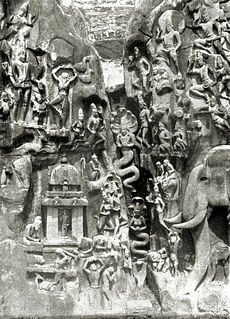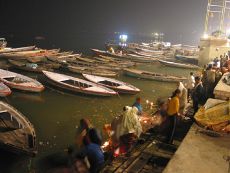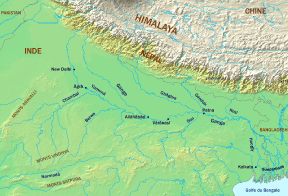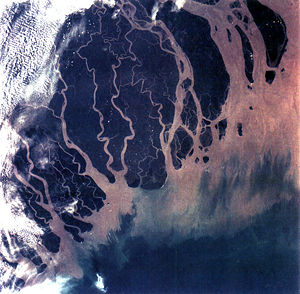Ganges River
- "Ganga" redirects here.
- "Ganges" redirects here.
| Ganges (Ganga) | |
|---|---|
| | |
| Origin | Gangotri, Himalayas |
| Mouth | Bay of Bengal |
| Basin countries | India, Bangladesh |
| Length | 2,510 km (1,560 mi) |
| Source elevation | 7,756 m |
| Avg. discharge | 14,270 m³/s (275,496 ft³/s) |
| Basin area | 907,000 km² (354,300 mi²) |
The Ganges River (Ganga in Indian languages; Ganges is the Latin form) (Devanagari गंगा) is a major river in northern India and Bangladesh. It originates as the Bhagirathi from the Gangotri Glacier in the Uttaranchal Himalaya and joins the Alaknanda near Deoprayag to form the Ganga. Then on, the Ganga flows across the large plains of North India (called the Gangetic Plains) and empties into the Bay of Bengal after dividing up into many distributaries. One of them is the Hoogli River near Kolkata, another major distributary being the Padma River that enters Bangladesh and merges with Jamuna River, a branch of the Brahmaputra River.
The total length of the river is about 2,510 km (1,560 mi). One of the densest human population belts on earth is built around the Ganges.
The region encompassing the delta near the Bay of Bengal coast is known as The Sundarbans (Beautiful Forests) — a region of thick mangrove forests, and one of the major habitats of the Royal Bengal tiger.
The Ganges Basin is incredibly fertile and, at present, about one in every 12 people in the world (8%) live in its catchment area. However, due to this incredible concentration of population, pollution and destruction of habitats is increasing at an alarming rate in the region.
The Yamuna River — a major river in its own right, and nearly as sacred — is a tributary of the Ganga, and their confluence is near what is the site of the traditional holy Hindu city of Prayag, now known as Allahabad.
Two species of dolphin can be found in the Ganges, the Ganges River Dolphin and the Irrawaddy Dolphin. The Ganges is also notable in that it contains a rare species of freshwater shark, Glyphis gangeticus about which little is known.
The Ganga in Hinduism
The Ganga is personified in Hinduism as a goddess: Maa Ganga (Mother Ganga). Hindu legend makes her the foster-mother of Karttikeya, who was actually a son of Shiva and Parvati
Several places sacred to Hindus lie along the banks of the river Ganga, including Haridwar and Varanasi. It is believed that taking a dip in the river will wash away one's sins, and that having one's ashes disposed of in the Ganga after death may improve one's next life or even allow Moksha to be attained sooner. Devout Hindus make pilgrimages to bathe in the Ganga and to meditate on its banks.
According to mythological legend, Brahma collected the sweat of Vishnu's feet and created Ganga. Being touched by two members of the Trimurti, Ganga became very holy.
Several years later, a king named Sagara magically acquired sixty thousand sons. One day, King Sagara performed a ritual of worship for the good of the kingdom. One of the integral parts of the ritual was a horse, which was stolen by the jealous Indra. Sagara sent all his sons all over the earth to search for the horse. They found it in the nether-world (or Underworld) next to a penitent sage Kapila. Believing that the sage had stolen the horse, they hurled insults at him and caused his penance to be disturbed. The sage opened his eyes for the first time in several years, and looked at the sons of Sagara. With this glance, all sixty thousand were burnt to death.

The souls of the sons of Sagara wandered as ghosts since their final rites had not been performed. When Bhagiratha, one of the descendants of Sagara, son of Dilip, learnt of this fate, he vowed to bring Ganga down to Earth so that her waters could cleanse their souls and release them to heaven.
Bhagiratha prayed to Brahma that Ganga come down to Earth. Brahma agreed, and he ordered Ganga to go down to the Earth and then on to the nether regions so that the souls of Bhagiratha's ancestors would be able to go to heaven. The vain Ganga felt that this was insulting and decided to sweep the whole earth away as she fell from the heavens. Alarmed, Bhagiratha prayed to Shiva that he break up Ganga's descent.
Ganga arrogantly fell on Shiva's head. But Shiva calmly trapped her in his hair and let her out in small streams. The touch of Shiva further sanctified Ganga. As Ganga travelled to the nether-worlds, she created a different stream to remain on Earth to help purify unfortunate souls there.
Because of Bhagiratha's efforts Ganga descended on to earth and hence the river is also known as Bhagirathi, and the term "Bhagirath prayatna" is used to describe valiant efforts or difficult achievements.
Another name that Ganga is known by is Jahnavi. Story has it that once Ganga came down to earth, on her way to Bhagiratha, her rushing waters created turbulence and destroyed the fields and the sadhana of a sage called Jahnu. He was angered by this and drank up all of Ganga's waters. Upon this, the Gods prayed to Jahnu to release Ganga so that she could proceed on her mission. Pleased with their prayers, Jahnu released Ganga (her waters) from his ears. Hence the name "Jahnavi" (daughter of Jahnu) for Ganga.
Pollution

The Ganges collects large amounts of human pollutants as it flows through highly populous areas. These populous areas, and other people down stream, are then exposed to these potentially hazardous accumulations. While proposals have been made for remediating this condition so far no great progress has been achieved. The Ganga remains an economically important waterway and polluting it remains economically advantageous.
The major polluting industries on the Ganges River are the leather industries, especially near Kanpur, which use large amounts of chromium and other chemicals, and much of it finds its way into the meager flow of the Ganga. Unfortunately, this is a boom time for leather processing in India, which many view as a form of eco-environmental dumping on the third world, and with the lax and lubricable implementation systems of the Uttar Pradesh government, it does not seem likely that this will go down. The world bank report 1992, which focussed on the environmental issues, mentions the dissolved-oxygen and riverborne decomposing material at two points on the Ganga.
However, industry is not the only source of pollution. Sheer volume of waste — estimated at nearly 1 billion litres per day - of mostly untreated raw sewage — is a significant factor. Also, inadequate cremation procedures contributes to a large number of partially burnt or unburnt corpses floating down the Ganga, in addition to livestock corpses.
The Ganga Action Plan has been set up under the Indian Government bureaucracy, and is attempting to build a number of waste treatment facilities, under Dutch and British support, and to collaborate with a number of voluntary organizations. Surprisingly, the Hindu political parties in India are not very active in the efforts to clean up the Ganga, and it is not very high in the general religious agenda. India's government has already spent over $33 million to address the overwhelming sewage problem. However, things are looking better at the beginning of 2006, as satellite images show increased water clarity in the river.
Credits
New World Encyclopedia writers and editors rewrote and completed the Wikipedia article in accordance with New World Encyclopedia standards. This article abides by terms of the Creative Commons CC-by-sa 3.0 License (CC-by-sa), which may be used and disseminated with proper attribution. Credit is due under the terms of this license that can reference both the New World Encyclopedia contributors and the selfless volunteer contributors of the Wikimedia Foundation. To cite this article click here for a list of acceptable citing formats.The history of earlier contributions by wikipedians is accessible to researchers here:
The history of this article since it was imported to New World Encyclopedia:
Note: Some restrictions may apply to use of individual images which are separately licensed.

